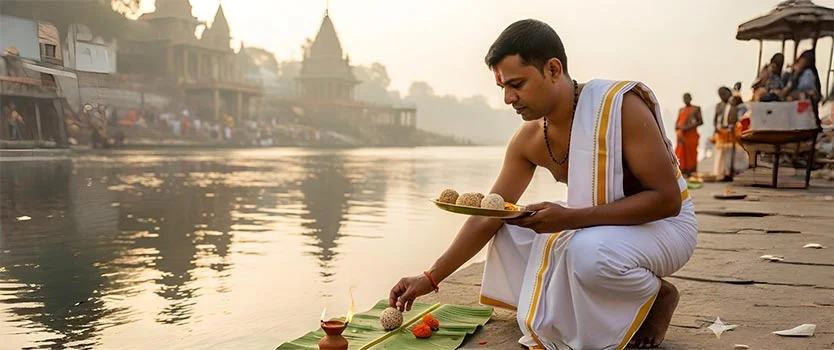Spiritual Importance of Pind Daan in Hindu Culture

Life is beautiful, and it cannot be complete without the recognition of our roots and our ancestors. Pind Daan is one of the holiest ceremonies in the Hindu tradition in honor of ancestors. It is said that this ritual with devotion will bring peace to the dead souls and good luck to the family. Let’s understand all about this holy act, its significance, value, rituals, and the expense of this miracle.
The Meaning of Pind Daan
Pind means a round offering composed of rice, barley flour, and sesame seeds, and Daan means donation or offering. Collectively, Pind Daan is the service of food to the spirits of our ancestors, typically on the banks of sacred rivers. This is performed to symbolize the transfer of peace and liberation (Moksha) to the dead and the safe journey of their soul in the afterlife.
Importance of Pind Daan in Hindu Culture
Pind Daan has long been a spiritually important part of Hindu culture. It is even said that in the absence of Pind Daan, the departed soul might not be able to get full peace. This ritual is done by families to:
- Show appreciation to their ancestor.
- Break ancestral karma obstacles (Pitru Dosha).
- May you be blessed with good health, good luck, and family peace.
- liberate the soul and move him toward Moksha.
Essentially, Pind Daan is not a ritual, but rather a heartfelt connection between the living and the deceased( dead).
How is Pind Daan Done?
Pind Daan is a highly religious ceremony. The ritual is performed by a learned priest (Pandit Ji). Common steps include:
- Making pindas of rice, sesame, and flour.
- Providing pindas, as well as water and prayers to the spirits of the dead.
- Among the sacred rivers such as the Ganga, Phalgu, or holy sites such as Gaya, Varanasi, and Prayagraj.
- After the ritual, feeding Brahmins or the poor means to be charitable and grateful.
There may be some variations to this ritual depending on the traditions of the region, but its purpose is to protect the peace of the ancestors.
Rules and timing of pind daan
In order to make sure that the ceremony is properly and honorably carried out, one has to remember a great number of rules and guidelines. When, after death, is Pind Daan sometimes asked? The ritual is usually conducted once an individual dies to ensure his or her soul rests in peace, especially on the 13th day ritual or the Pitru Paksha fortnight.
- Who Can Perform: In the traditional culture, Pind Daan is performed by the eldest son or a male child; however, today, we can also see women performing this ritual.
- Best Time to perform Pind Daan: During Pitru Paksha (the fortnight of ancestors), the best time to perform Pind Daan is. That particular day is to be related to the lunar day (Tithi) on which the ancestor died.
- Sattvic Diet: This individual who is performing the ritual should eat a sattvic (pure) diet, but one that does not include non-vegetarian food, or onion or garlic.
Understanding Pind Daan
Along with the ritual element, Pind Daan is a reminder of our responsibilities towards our ancestors. It helps us to always remember that we are not alone on this earth but are part of a bigger family that continues to go on through the generations. By doing Pind Daan, we recognize our origin and honor our ancestors who set the path of our lives
Significance and Beliefs
Scriptures show that during Pitru Paksha, the ancestors impatiently expect their descendants(son) to offer them. Whenever Pind Daan is done with the genuine spirit, the ancestors will bring the family good fortune, peace, and safety. However, on the other hand, failure to undertake such rituals is indicated to cause Pitru Dosha, which causes difficulties in career, health, or relationships.
Cost and Expenses List of Pind Daan.
The Pind Daan may cost between ₹3,000 to 15,000 on average, depending on the location and rituals. The cost may be increased slightly to include other rituals and arrangements at popular pilgrimage destinations like Gaya or Varanasi.
Pind Daan little costly, and the cost depends on the place and rituals involved. Costs may include:
- Products to prepare Pind (rice, sesame, flour, etc.).
- Flower, incense, and holy water are used during the Puja.
- Brahman Dakshina (Gifts given to priests).
- Giving charity and food to the poor.
Pandit Ji charges Pind Daan
The charges of Pandit Ji charge according to their knowledge, the nature of the rituals being conducted, and the place of worship selected. Typically, the charges are between 1500 and 5000 rupees, which include their guidance, chanting of mantras, and the full process of the puja. Most families will want the help of experienced priests(pandit) because they want each part of the ritual to be authentic and filled with facts.
Conclusion
The Pind Daan is not simply a ceremony, but a sentimental flow of affection, admiration, and honor to our ancestors. It is also a form of recalling our place of origin and making sure our loved ones get a peaceful afterlife. The Pind Daan ceremony eliminates old barriers, fills our lives with peace and prosperity.
In the current era, whether through the conventional methods of performing the ritual at sacred sites or through the internet, it is the motive of the ritual that will actually count. When we do Pind Daan with a deep sense of devotion, we end up tying the knots of our own lives too, and in the process, ensuring that we offer calmness to our ancestors.
Our priesthood(pujari) of experts conducts the real Pind Daan rituals in our holy places, allowing you to access your ancestors and request their blessings. Know more about Pind Daan Puja, Chat with our astrologers now, and bring peace, prosperity, and positivity in your life.
Also Read: The Sun in 9th House: Vedic Astrology
Frequently Asked Questions
Pind Daan is a sacred Hindu ritual where offerings of rice balls, called “pind,” are made to honor ancestors. The concept is to provide spiritual nourishment to their souls and help them achieve liberation from the cycle of rebirth.
Pind Daan is traditionally performed after a person’s death to ensure their soul finds peace. It is considered most auspicious and effective when performed during the Pitru Paksha fortnight.
There are several types of Pind Daan, including the ceremonial Gaya Pind Daan for salvation, and the more regular shraddh and tarpan offerings. Each type serves a specific purpose in honoring the deceased.
The most revered Pind Daan places in India are holy cities like Gaya in Bihar, Varanasi (Kashi), and Haridwar. These locations are believed to have special spiritual significance for performing the ritual.









